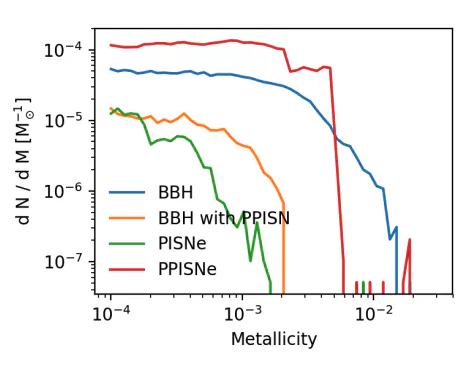The impact of pair-instability mass loss on the binary black hole mass distribution. ApJ
Aug 1, 2019·,,,,,,·
2 min read
S Stevenson
ML Sampson
J Powell
A Vigna-Gómez
C Neijssel
D Szécsi
I Mandel

Abstract
A population of binary black hole mergers has now been observed in gravitational waves by Advanced LIGO and Virgo. The masses of these black holes appear to show evidence for a pileup between 30 and 45 M⊙ and a cutoff above ∼45 M⊙. One possible explanation for such a pileup and subsequent cutoff are pulsational pair-instability supernovae (PPISNe) and pair-instability supernovae (PISNe) in massive stars. We investigate the plausibility of this explanation in the context of isolated massive binaries. We study a population of massive binaries using the rapid population synthesis software COMPAS, incorporating models for PPISNe and PISNe. Our models predict a maximum black hole mass of 40 M⊙. We expect ∼10% of all binary black hole mergers at redshift z = 0 will include at least one component that went through a PPISN (with mass 30–40 M⊙), constituting ∼20%–50% of binary black hole mergers observed during the first two observing runs of Advanced LIGO and Virgo. Empirical models based on fitting the gravitational-wave mass measurements to a combination of a power law and a Gaussian find a fraction too large to be associated with PPISNe in our models. The rates of PPISNe and PISNe track the low metallicity star formation rate, increasing out to redshift z = 2. These predictions may be tested both with future gravitational-wave observations and with observations of superluminous supernovae.
Type
Publication
The Astrophysical Journal 882 (2), 121
A population of binary black hole mergers has now been observed in gravitational waves by Advanced LIGO and Virgo. The masses of these black holes appear to show evidence for a pileup between 30 and 45 M⊙ and a cutoff above ∼45 M⊙. One possible explanation for such a pileup and subsequent cutoff are pulsational pair-instability supernovae (PPISNe) and pair-instability supernovae (PISNe) in massive stars. We investigate the plausibility of this explanation in the context of isolated massive binaries. We study a population of massive binaries using the rapid population synthesis software COMPAS, incorporating models for PPISNe and PISNe. Our models predict a maximum black hole mass of 40 M⊙. We expect ∼10% of all binary black hole mergers at redshift z = 0 will include at least one component that went through a PPISN (with mass 30–40 M⊙), constituting ∼20%–50% of binary black hole mergers observed during the first two observing runs of Advanced LIGO and Virgo. Empirical models based on fitting the gravitational-wave mass measurements to a combination of a power law and a Gaussian find a fraction too large to be associated with PPISNe in our models. The rates of PPISNe and PISNe track the low metallicity star formation rate, increasing out to redshift z = 2. These predictions may be tested both with future gravitational-wave observations and with observations of superluminous supernovae.